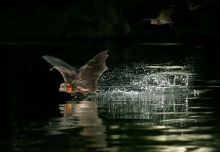Feeding & drinking
Flying-foxes carry pollen and seeds over large areas, contributing to the genetic health of forests and woodland. Grey-headed flying-foxes feed on the flowers or fruits of more than 100 native plants, mostly trees. Each tree species flowers at the same time to attract pollinators. Most of these plants are dominant trees which are structural elements in forests and woodlands.
View or download a list of native food plants:Grey_headed_flying_fox_native_diet_species
Read more about a study of the pollination of eucalypts by flying-foxes, undertaken in northern Australia: McCoy_Pollination_of_eucalypts_by_flying-foxes_1990
When do they feed?
- Flying-foxes leave their day-time roost shortly after sunset to forage for food, usually about 20km from camp
- Some flying-foxes have been tracked moving much longer distances, up to 100 km during a night, flying between patches of flowering trees
- Noises in the trees may alert you to feeding flying-foxes
- At other times they feed quietly with only the rustle of leaves to indicate they are there
What do they eat?
- The diet of grey-headed flying-foxes is mainly nectar and pollen from the flowers of eucalypts, angophoras, bloodwoods, turpentine, paperbark and banksia (55 native species recorded)
- They also eat the fruit of many rainforest plants such as figs, lilly pillies, koda, plum pine (50 native species recorded)
- They also chew leaves of plants such as mangroves
- Since European settlement of Australia, flying-foxes have learned to feed on many introduced plants, sometimes bringing them into conflict with humans. View or download a list of these plants:grey_headed_flying_fox_non_native_diet_species
Is their feeding territorial?
- Many individuals return to the same tree nightly, until flowering or fruiting ceases
- Dominant flying-foxes will actively defend their feeding territory, a branch in a tree
- Subordinate flying-foxes will be repelled with loud calls and wing spreading
- Rivals will be repeatedly chased out of the feeding territory, departing with a mouthful of fruit or face covered in nectar and pollen
How do they drink?
- Flying-foxes drink by licking water from their fur or from leaves
- They also lick water from their fur after belly-dipping. With great skill they skim the water surface of a river or pool then land in a tree to lick their wet fur
For more information on drinking visit Vivien Jones’ website Flying-foxes on Belllingen Island

